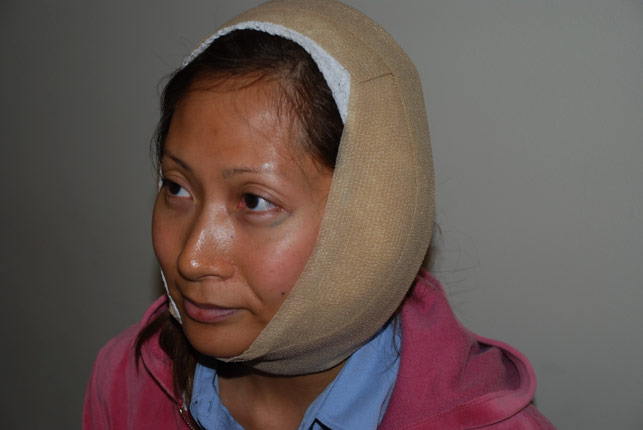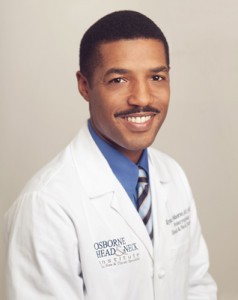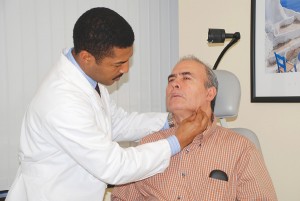- India Medical Mission 2018 - November 1, 2018
- Sleep Disorders: Sleep Apnea and Upper Stimulation Therapy - August 25, 2015
- The Naked Vocalist Podcast Featuring Dr. Reena Gupta - May 27, 2015
- New Therapy for Sleep Apnea – First Sleep Pacemaker placed in California at Osborne Head and Neck Institute. - December 12, 2014
- Boxer’s Ear: Can your ear explode? - December 12, 2014
- Nose Picking (Rhinotillexis) and Septal Perforations: Why I should stop picking my nose…? - November 24, 2014
- Deviated Septum and Septal Perforation - July 28, 2014
- Hereditary Hemorrhagic Telangiectasia: Nasal Septal Perforation Repair - June 25, 2014
- Dr. Mantle recognized at the Beverly Hills Medical Science Academy Awards - May 8, 2014
- Commonly Misdiagnosed Pathologies: Arteriovenous Malformations - April 9, 2014
Can sialocele be prevented when undergoing salivary gland surgery?
Question: I have been evaluated for a salivary gland mass by a head and neck surgeon and he has recommended the removal of a large portion of my parotid gland. He mentioned that this surgery is associated with several potential risks and complications, one of which is a sialocele. I understand that a sialocele can be a potentially painful and intrusive lesion. Is there a way to prevent the formation of a sialocele when undergoing salivary gland surgery?
Discussion:
Sialoceles are a complication of surgical or physical trauma to the salivary glands. The best way to prevent formation of a sialocele is to seek treatment from an experienced salivary gland specialist. A qualified specialist emphasizes three critical aspects of treatment:
- Precise removal of the affected salivary gland mass
- Proper management of the remaining glandular tissue and associated ductal structures
- Close postoperative management and care
Through meticulous and experienced technique, salivary gland specialists are able to effectively treat disorders of the salivary gland while minimizing the complications associated with surgery, including sialocele formation. These physicians carefully dissect around the delicate structures that overlie and surround the salivary glands thereby preventing potentially serious complications such as facial paralysis, taste distortion, and disfigurement. Once resection of the affected salivary gland has been completed, proper management of the remaining glandular tissues is crucial to avoid sialocele formation.

An experienced specialist will ensure that after removing or altering the glandular structure, they identify and seal off any left over tributaries to the ductal system. This painstaking and advanced technique inhibits sialocele formation by preventing saliva from pooling within surrounding tissues of the cheek. Traditional procedures do not typically address these potential leaks, let alone the inherent postoperative considerations.
Proper postoperative care comprised of close followup and dietary modifications are also important factors in sialocele prevention. A salivary gland specialist will closely follow you and examine your surgical site for proper drain management, wound healing, scar formation, and infection prevention. Special compressive dressings and small drains are placed at the surgical site to promote proper fluid drainage as well as to close off any potential areas where saliva can accumulate. In addition to suppressing sialocele formation, this deters bacterial accumulation and infection. Dietary modifications are also prescribed to prevent the production of excess saliva during the healing phase.
It is highly advisable that you consult a salivary gland specialist before undergoing any salivary gland procedure.
Dr. Ryan Osborne, Director of Head and Neck Surgery at the Osborne Head and Neck Institute, regularly performs salivary gland procedures and is an expert in sialocele prevention. Dr. Osborne has developed his own cutting edge and specialized techniques for the treatment of salivary gland disorders. He has gained widespread acclaim for his advanced techniques and superior outcomes.
To learn more about sialocele prevention and salivary gland procedures, please contact the Osborne Head and Neck Institute.
Key Points:
- The best way to prevent formation of a sialocele is to seek treatment from an experienced salivary gland specialist.
- Successful prevention of a sialocele includes: precise removal of the affected salivary gland mass; proper management of the remaining glandular tissue and associated ductal structures; and close postoperative management and care.
- An experienced specialist will ensure that after removing or altering the glandular structure, they identify and seal off any left over tributaries of the ductal system.
- Traditional procedures do not typically address these potential leaks, let alone the inherent postoperative considerations.
- Proper postoperative care comprised of close followup and dietary modifications are also important factors in sialocele prevention.
- A salivary gland specialist will closely follow you and examine your surgical site for proper drain management, wound healing, scar formation, and infection prevention.
- Dr. Ryan Osborne, Director of Head and Neck Surgery at the Osborne Head and Neck Institute, regularly performs salivary gland procedures with unparalleled success rates.



